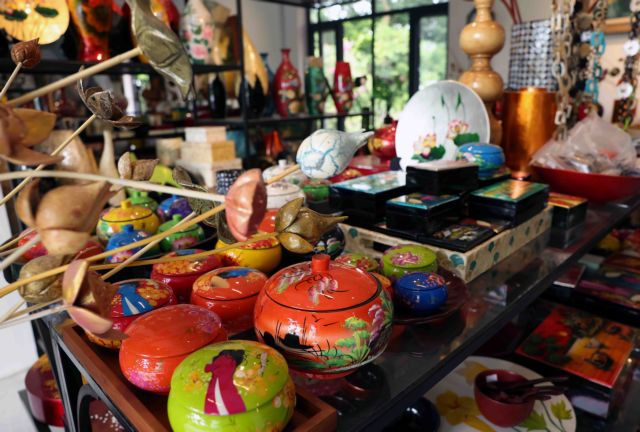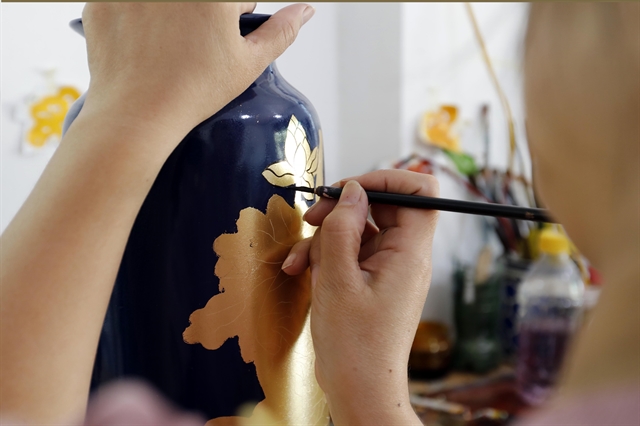 Life & Style
Life & Style


|
| Lacquer products from Hạ Thái Village in Duyên Hà Commune, Thường Tín District, Hà Nội, are exported to markets in Europe, Japan, and South Korea. Photos courtesy of Hanoi Rural Development Sub-department |
Located about 20 kilometres south of downtown Hà Nội, Hạ Thái Village in Duyên Thái Commune, Thường Tín District, is renowned for its lacquerware craftsmanship.
Over the centuries, artisans in this village -- one of seven craft village tourist attractions near the capital city -- have continuously innovated to create exquisite handicrafts that meet the demands of consumers both domestically and internationally.
Hạ Thái villagers are uncertain about the exact origins of their lacquerware craft, but it has been present since at least the 17th century, as evidenced by two lacquered and gilded couplets displayed in the village's communal house.
At that time, Hạ Thái was primarily known for its decorative lacquer work and was valued for its many skilled artisans. Because they specialised in crafting items for the royal court, the village earned the nickname "the village that serves the king."

|
| Lacquerware production at a household in Hạ Thái Village. |
In the 1930s, Hạ Thái's lacquer art experienced significant changes during the cultural exchange between East and West. The first Vietnamese painters trained at the Indochina Fine Arts School began to incorporate new materials such as eggshells, seashells and bamboo cores. Notably, they introduced polishing techniques, leading to the development of a distinctive lacquerware style.

|
| Decorative patterns on a lacquerware product in Hạ Thái Village. |
According to the local artisans, each lacquerware product, whether as small as a bowl or as grand as a painting, requires meticulous craftsmanship and skill at every stage of production.
Through the deft hands of these talented craftsmen, the natural beauty of Việt Nam is vividly captured while maintaining the charming and gentle essence of rural life.

|
| Hạ Thái Village is one of the seven craft village tourism destinations in Hà Nội, renowned for its lacquerware craftsmanship. |
The lacquerware features elegant shapes and vibrant ethnic patterns, depicting scenes such as water wharves with banyan trees, bamboo boats, the One Pillar Pagoda, and Hà Nội's Old Quarter, making them particularly popular among both domestic and international consumers.
The lacquer paintings from Hạ Thái Village feature traditional materials such as cockroach wing lacquer, silver leaf, mother-of-pearl and gold leaf, primarily painted on a black background.
The incorporation of polishing techniques has contributed to a unique lacquerware style, leaving a distinct mark that has established a brand identity for Hạ Thái lacquerware as a renowned art form.
The village was officially recognised as a craft village tourism destination in Hà Nội in 2020. According to Nguyễn Văn Chí, Head of the Hanoi Rural Development Sub-department, this recognition marks an important milestone in strengthening the brand of local craft products and aligns Hạ Thái with recent development trends.

|
| Tourists admiring lacquer products of Hạ Thái Village. |
Since its designation as a tourist craft village, local authorities have shown increased interest in developing this 'smokeless industry', he added.
With support from the local authorities, Hạ Thái villagers have expanded their business models to enhance visibility and boost the village's economy. By showcasing Việt Nam's unique painting materials, Hạ Thái has established itself as a reputable destination for both local and international customers, with its products now available in many countries, including the UK, France, Russia, the US, Spain, Australia, Italy, Japan and South Korea.
According to the head of the Hanoi Rural Development Sub-department, Hạ Thái lacquerware and its over 300-year tradition has now gained new vitality, firmly establishing itself among the renowned craft villages in Việt Nam.
The lacquer products of the village have been showcased and admired by visitors at numerous craft fairs and exhibitions both domestically and internationally.
Speaking about the preservation and development of the craft village, Nguyễn Thị Hồi, Chairwoman of the Hạ Thái Lacquerware Craft Association, emphasised the need for continuous innovation to adapt to changing times.
"We are aiming to develop the craft village into an attractive and professional tourist destination. Workshops are collaborating to train the younger generation, while also equipping villagers with knowledge about tourism.
"We plan to enhance facilities at the production workshops to provide visitors with hands-on experience of various stages in the lacquerware production process," she added. VNS
This article is written in collaboration with the Hanoi Rural Development Sub-department.